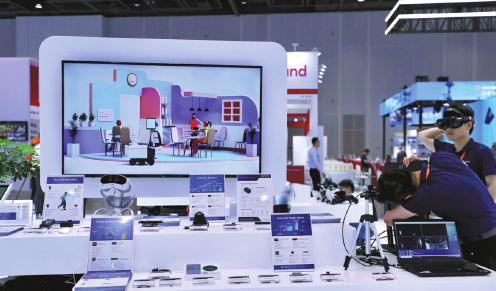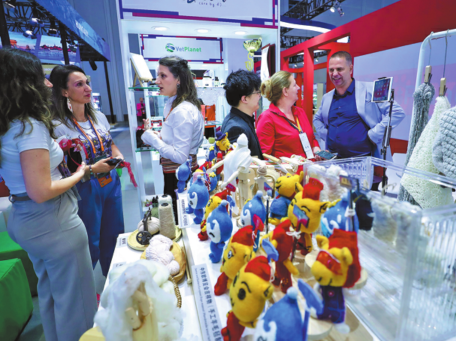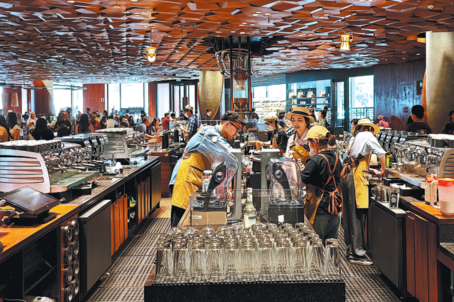China-CEEC business ties win-win for both
Engagement will give fresh momentum for multilateral cooperation, green growth and BRI in coming years, say experts


Growing business engagement between China and Central and Eastern European countries (CEEC) will deliver long-term benefits for both sides, providing fresh momentum for multilateral cooperation, green growth and the Belt and Road Initiative in the years ahead, said government officials and business leaders.
Speaking at the ongoing fourth China-CEEC Expo in Ningbo, East China's Zhejiang province, they emphasized the importance of deepening cooperation in trade, investment and innovation.
The event is a key platform for showcasing signature products from the CEEC, boosting imports from the region, and advancing twoway investment between China and the CEEC, according to information released by China's Ministry of Commerce.
Matevz Frangez, state secretary at Slovenia's Ministry of the Economy, Tourism and Sport, who is leading a Slovenian delegation including 25 companies across sectors such as high-tech, food and beverage, smart manufacturing and tourism, participated in the expo this week.
As the Guest of Honor at the event that runs till Sunday, Frangez said Slovenia hopes to deepen engagement with China's dynamic market, highlighting significant opportunities for cooperation in areas such as automotive, pharmaceuticals, food and wine, tourism, sports and port logistics.
Voicing confidence in the resilience and potential of China-Slovenia relations, he said Slovenia supports clear and strong rules for international trade and the need to reform the World Trade Organization to meet the challenges of a changing and globalized world.
Richard Rasi, chairman of the Slovak National Council, said Slovakia seeks to not only import goods from China, but also expand the presence of its own products and technologies in the Chinese market.
"We are committed to enhancing two-way trade and supporting small and medium-sized enterprises in achieving greater development amid a competitive market environment," said Rasi.

Trade value between China and the CEEC amounted to $142.3 billion in 2024, up 6.3 percent year-on-year — 2.5 percentage points higher than China's overall foreign trade growth rate, data from the General Administration of Customs, or the GAC, showed.
This trend continued its growth momentum in the first four months of this year, with bilateral trade rising 5.6 percent on a yearly basis to 329.68 billion yuan ($45.76 billion).
China mainly exports construction machinery, computers, manufacturing equipment, steel, textiles, garments and household appliances to the CEEC. Other key exports include lighting products, smartphones, trains, trucks and passenger vehicles, as well as power storage systems and photovoltaic equipment.
Apart from agricultural products such as wine, meat, dairy, sunflower oil, fruit and cereals, CEEC's exports to China include commodities and industrial goods like copper and iron ore, automotive components, tires, non-alloy steel products, electrical machinery, medical equipment and wood-based materials.
Serving as vital platforms for presenting technological advances and forging cross-border business partnerships, the fourth China-CEEC Expo spans 80,000 square meters this year, with the newly launched"Smart CEEC" section standing out as a key highlight.
It features nearly 100 high-end technologies and products from China and the CEEC, covering areas such as artificial intelligence, robotics and general aviation technology, according to the fair's organizers.
CEE countries are exhibiting a range of innovative technologies, particularly in the fields of aviation and biomedicine, including a light aircraft from Austria, maritime safety sensors from Serbia and medical equipment from Slovakia.
Lin Meng, director of the Modern Supply Chain Research Institute at the Beijing-based Chinese Academy of International Trade and Economic Cooperation, said that with both sides investing heavily in regional connectivity, manufacturing and modern agriculture, China and the CEEC have emerged as strong advocates of the multilateral trading system and global investment growth.
They also hold significant potential for cooperation in industrial and supply chain coordination, infrastructure development and cross-border e-commerce, given their complementary strengths in supply and demand, she said.
For example, the two sides have seen more robust investment activities; China's investment in the CEEC exceeded $24 billion by May 9, data from the Ministry of Commerce showed.
Yan Dong, vice-minister of commerce, said that investment cooperation between China and the CEEC has seen fresh momentum in recent years, particularly driven by Chinese businesses in the electric vehicle and power battery sectors.
"These companies are actively expanding their presence in the region through increased investment, project planning and industrial chain integration," said Yan.
One such company is Chinese EV manufacturer BYD, which announced in mid-May the establishment of its European headquarters in Budapest, Hungary, a milestone in China-European Union cooperation on new energy.
In addition to conducting advanced research on intelligent driving assistance and next-generation automotive electrification technologies, BYD's European headquarters will serve as a hub for sales, after-sales services, testing and the development of localized vehicle models. It is expected to create over 1,000 jobs, said the Shenzhen, Guangdong province-based company in a press release.
Looking ahead, BYD plans to collaborate with at least three Hungarian universities on joint scientific projects and partner with local suppliers and businesses to support the upgrading of the new energy vehicle industry chain.
Further underscoring the deepening economic ties, workers at the intelligent production facility of Ningbo Ruyi Joint Stock Co Ltd were busy assembling a batch of new energy forklifts in mid-May.
The company is a Ningbo, Zhejiang-based manufacturer of manual and electric forklifts, trucks and stackers.
These autonomous vehicles are scheduled for delivery to Budapest, where they will soon be deployed in a major local logistics park.
Markets of the CEEC have seen a rapid surge in demand for green and intelligent logistics equipment, said Chu Jiang, the company's chairman.
From January to April this year, the value of Ningbo Ruyi's exports to the CEEC, including forklifts and electric pallet trucks, grew by 28.6 percent year-on-year, according to Ningbo Customs.
"Our self-developed lithium-powered equipment, in particular, now accounts for 60 percent of orders from the region, thanks to our long battery life solutions and fast-charging capabilities," Chu said, noting that the company has actively seized opportunities brought by the BRI in recent years, focusing on intelligent and green transformation.
"To address the specific operational needs of the CEEC, particularly during the long winter seasons in places like the Czech Republic, Slovakia and Poland, we have introduced low-temperature antifreeze hydraulic systems and anti-skid tires," said Chu. "These tailored solutions have contributed to a steady increase in the company's market share across the region."
Ningbo, a major hub for China-CEEC trade, saw its exports to the CEEC surge 24.1 percent year-on-year to 16.07 billion yuan between January and April, statistics from Ningbo Customs showed.
Zhao Zenglian, the GAC's vice-minister, said that future cooperation between China and the CEEC will be bolstered by China's push for high-standard opening-up and the establishment of economic and trade platforms that promote and safeguard bilateral ties.
Thanks to the rapid development of connectivity and the tangible growth brought by the BRI, CEEC have become important destinations for the China-Europe freight train service, while the total number of direct air routes connecting China and CEEC now exceeds 30, according to the Ministry of Commerce.




































